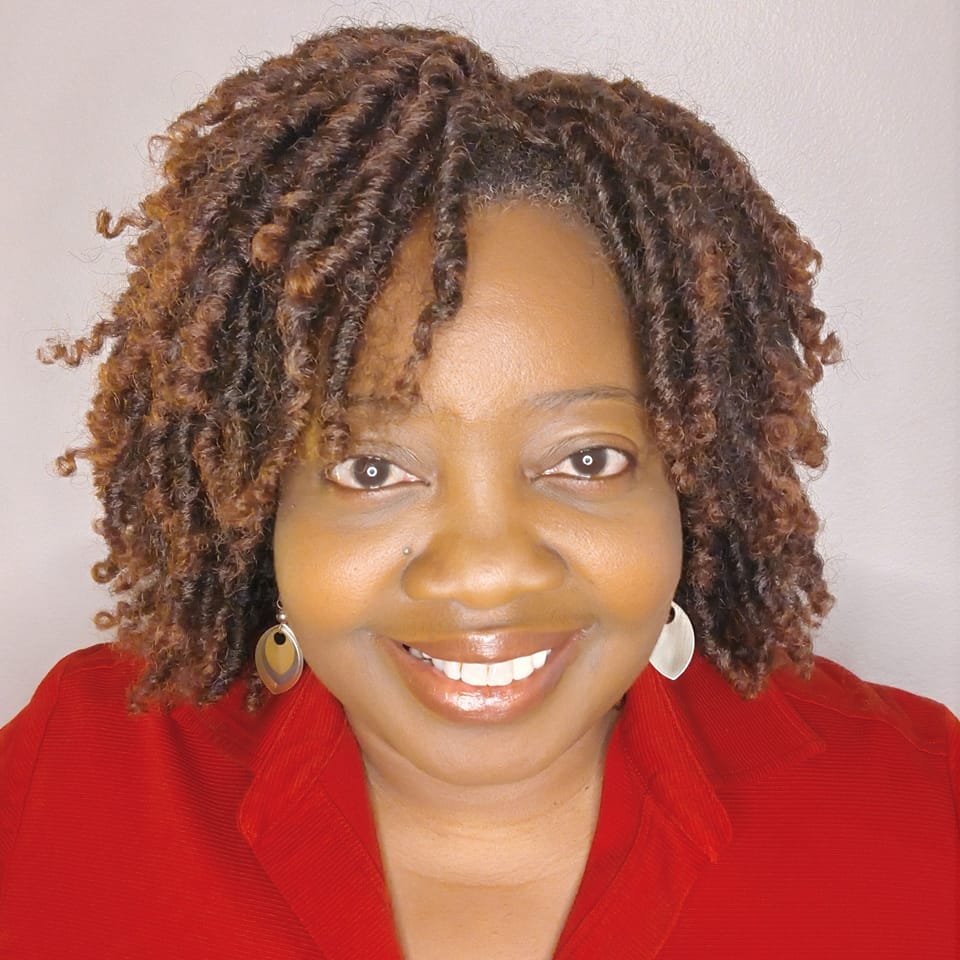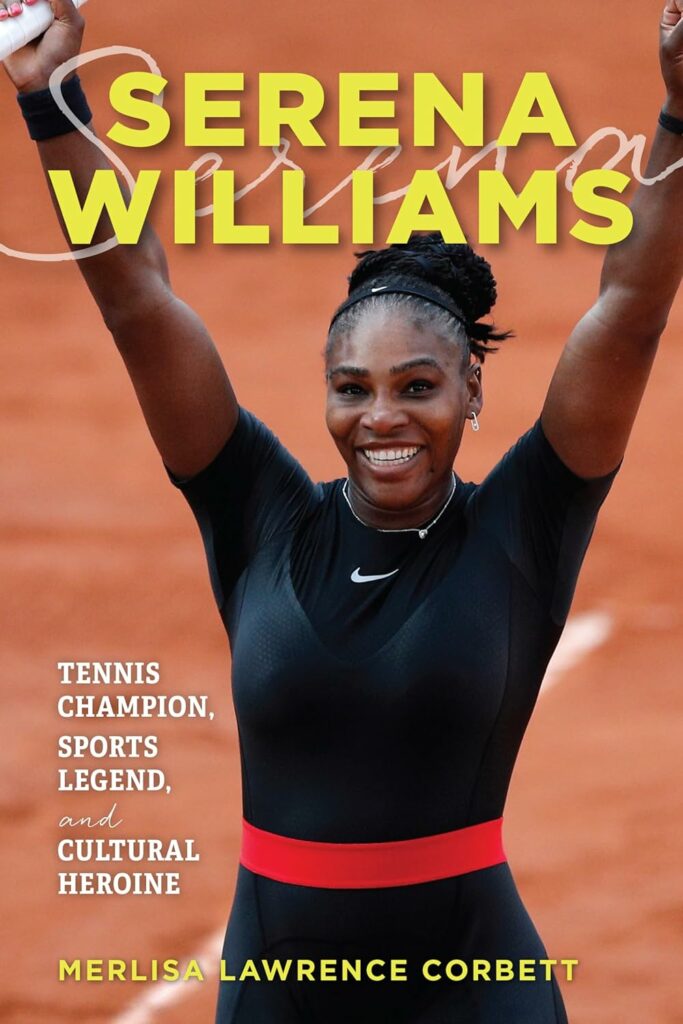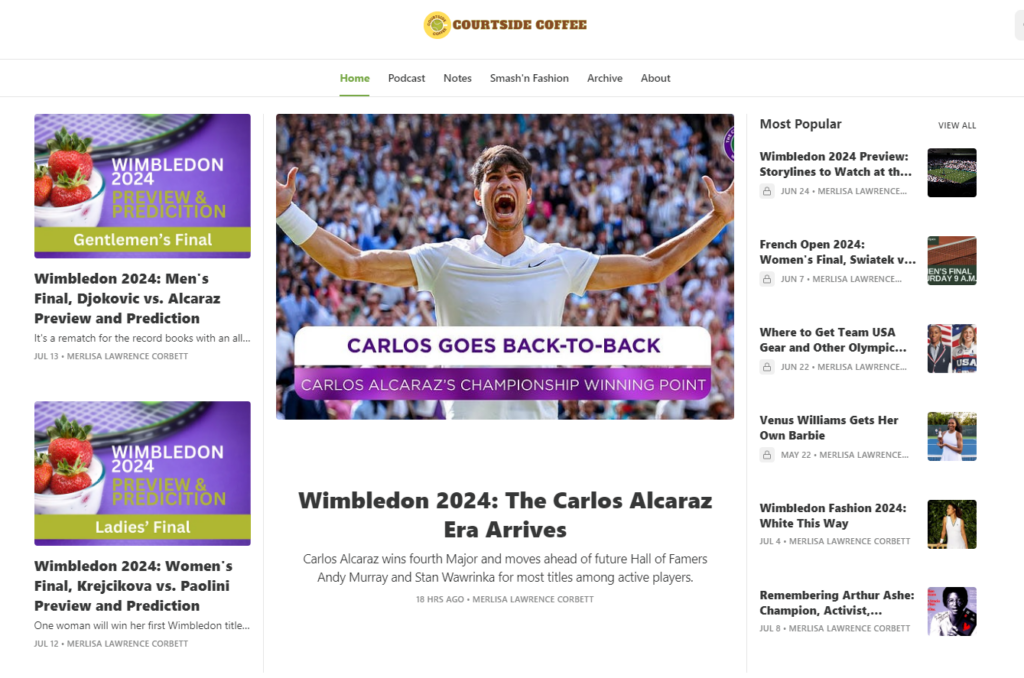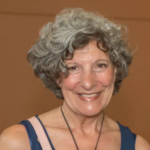Weekend nights when other University of South Florida students partied, Merlisa Lawrence Corbett could be found covering a football or basketball game. Decades later, Corbett is still happy to be in the game.
Once she settled on sports writing as a college major, “everything clicked,” Lawrence Corbett says. “It was as if I’d always been a sportswriter, and my soul had been waiting for me to figure it out.”

Lawrence Corbett’s particular sports passion is tennis. She wrote a tennis column for Bleacher Report and penned a Serena Williams biography. She recently launched Courtside Coffee, a podcast and Substack newsletter that combines her love of tennis and coffee. When she’s not writing about it, she plays USTA league tennis.
In an email interview, Lawrence Corbett elaborated on how she got started, how not interviewing Gloria Vanderbilt led to an all-time favorite story, what she learned at Bleacher Report, and how she applies skills she’s picked up from ASJA volunteer work to her business.
Of all the sports you could have focused on, why tennis?
Early in my career, I didn’t focus on tennis. In college, I covered high school football and basketball for three daily newspapers — the USF Oracle, St. Petersburg Times (now the Tampa Times) and Lakeland Ledger. I barely had a social life. While my friends were out on Friday and Saturday nights, I covered games. I’d return to my dorm room, exhausted. It was worth it, especially when I had a byline in the St. Pete Times and my roommate would run around pointing to the paper and yell, “That’s my roomie! That’s my roomie!”
I’ve loved tennis for most of my life. I’m a fourth-generation Floridian, and when I was growing up, tennis was a big deal.
Eventually I left Florida and didn’t focus on tennis until I moved back in 2013. I’d stopped covering sports when my son was younger, and had been freelancing, mainly covering real estate and interior design. By the time I moved back, he was in high school and I wanted to get back into sports. I applied to the Bleacher Report University program. In exchange for writing for free, the company trained you in SEO writing, future-proofing stories, and using their content management system.
What was it like working at Bleacher Report?
I was happy to learn new online writing tricks and my “student” stories got more views than some Bleacher Report columnists. One day, a Bleacher Report editor called to say they wanted to sign me to a contract to be a tennis columnist. I figured I must be pretty good if they asked me to sign a contract, so I asked for more money and got it. I became one of their top tennis columnists. I did that for about four years until Bleacher Report had a massive layoff and decided social media posts would suffice for tennis coverage.
What are some of your most memorable interviews?
I’ve had coaches call me from the dentist’s office while they were still under sedation. I interviewed a guy who played Bozo the Clown after he got struck by lightning. I remember trying not to laugh while interviewing a mother whose three-year-old was mauled by their pet wolf. The kid survived. Cops had to shoot the wolf. The mom said of the wolf, “He loved kids.” Lord, I’m cracking up right now.
What’s one of your favorite stories?
One of my most memorable stories is about an interview I didn’t get. In 1988, I was covering cops for the Staten Island Advance. That summer, Carter Cooper – Gloria Vanderbilt’s son and Anderson Cooper’s brother – committed suicide by jumping from their 14th floor apartment. It was a huge story. I was home preparing for my evening shift when the city desk editor called telling me I had to cover Carter Cooper’s burial.
The funeral in Manhattan was closed to the press but the burial was at the Vanderbilt Mausoleum on Staten Island. I put on a nice black skirt and a matching jacket, drove to the cemetery, parked, and entered what looked like a welcome center. A Secret Service agent stopped me. He was there because Gloria Vanderbilt was being accompanied to the burial site by her good friend, Nancy Reagan, who was still the First Lady.
The Secret Service agent checked me out. As I turned to watch the funeral motorcade head toward the mausoleum, he let me go. No other reporters were there.
I walked to the burial site, just outside the mausoleum. They brought the coffin. There was a priest. Vanderbilt wore a beautiful white ensemble. She and Nancy Reagan stood arm in arm. There were three or four young people, who looked around my age, 22, close to the same age as Carter Cooper, who was 23. I’m assuming Anderson, who is a year younger, was among the young people. Fewer than ten people huddled around the coffin.
I stood close enough to Nancy Reagan to touch her. I kept staring at her wrist-sized neck. As skinny as she was, she appeared to keep Vanderbilt from collapsing. I wanted to remove my notebook and pen, but the Secret Service guys next to Nancy were different from the man who cleared me. I worried that if I reached into my purse while standing that close to the First Lady, I might get shot or jumped. So I took it all in: prayers, scripture readings, weeping. I wept, too. I had never been to a funeral.
Back in the office, I used my observations and AP wire stories to write the article despite not getting an interview. I got high fives from editors and fellow reporters. I’ll never forget it.

How did your book “Serena Williams: Tennis Champion, Sports Legend, and Cultural Heroine” come about?
The publisher, Rowman & Littlefield Publishers, wanted a new Serena Williams book because it had been nearly 10 years since the last comprehensive biography of her had come out. One of their authors recommended me. The publisher asked me to put together a book proposal. I did. They liked it.
You recently launched Courtside Coffee, a Substack newsletter and podcast for your tennis commentary. Why?
Courtside Coffee is an extension of my freelance writing. I watch, play, and talk about tennis all the time. I am also serious about my coffee. Courtside Coffee allows me to explore my favorite things while enhancing my content management skills.

It’s a ton of work. I am the content creator and manager. I approach my Substack as a media executive, building a brand. The weekly newsletter is just one part of Courtside Coffee. A Smash’n Fashion section covers clothing and interior design. Coffee Corner gives me a chance to write about coffee culture. I transformed part of a walk-in closet into a recording studio. I’m having a blast using audio editing software. Whether writing or doing a podcast, I’m improving my storytelling prowess.
You write for AARP and The Guardian. How do you split your time?
I like to have a mix of short turnaround projects, in-depth stories, and some long-term assignments. I don’t pitch stories I don’t like. I preserve time for dream projects, like a memoir I’m reworking. I seek consistency and variety. I need consistency to pay the bills and variety keeps things interesting.
How long have you been in ASJA, and why did you join the board?
I joined ASJA in 2011 because I realized freelance writing had become more than half of my income. I had been a long-time member of the National Association of Black Journalists and enjoyed the networking and friendships I gained attending NABJ conferences. ASJA offered something I wasn’t getting at NABJ, a focus on the business of being an independent writer.
You also manage ASJA’s social media accounts. What’s your secret to juggling paid and volunteer work?
I view volunteering as training, a learning experience that makes paid work better. Volunteering gives me a chance to connect with other writers. Freelancing can feel isolating. Belonging to a community of writers provides camaraderie and support.
To juggle everything, I use the Productivity Planner daily planner. Even with Google Calendar, Calendly, and other scheduling apps, I prefer to write things down. The Productivity Planner works for me because it forces me to prioritize and make choices.
What have you learned about running ASJA social media that other writers could apply to their business?
I’ve learned the importance of using data to drive planning. On an episode of the BBC News’ The Media Show, they talked about how most young people prefer getting news from podcasts. I’d added a podcast to Courtside Coffee, so I looked at my Substack data and found the engagement rate for my podcasts was higher than it was for my articles. More people were listening to what I said than reading what I wrote. That’s when I started investing more time and equipment in the podcast and using it to drive people to the Substack.
I also look at what successful media companies do and copy them. ESPN promotes its daytime content during primetime shows, so I include a “Next Week” preview promo on Courtside Coffee. PBS has sponsored content, why not Courtside Coffee? I got my favorite coffee roaster to sponsor my Coffee Corner. It wasn’t a $1,000 deal, but the owner paid for an annual subscription to a Substack that hadn’t published yet and had zero followers.
Michelle Rafter is a ghostwriter and ASJA member based in Portland, Oregon. She is ASJA’s publications chair, part of the 2024-2025 conference planning committee, and ran the organization’s 2023 virtual annual conference.
Browse Articles
Topic
Blogging & Social Media, Freelance Life, Craft & Writing Skills, Running Your Business

